Boulder Tree Care provides professional tree pruning for all our residential and commercial clients here in Boulder, Colorado.
 We provided the highest standards of tree care excellence in the industry. Our certified arborist has many years of practical, field experience and takes care to prune each tree using proper pruning techniques.
We provided the highest standards of tree care excellence in the industry. Our certified arborist has many years of practical, field experience and takes care to prune each tree using proper pruning techniques.
Due to the different growth patterns of tree species, locations, soil conditions, the history of maintenance, damage caused by storms and other factors, pruning has many definitions.

 Cleaning of the Crown is the most common type of tree pruning we provide. It includes the removal of damaged, diseased, dead, weak wood, and, branches that are not growing in a beneficial place.
Cleaning of the Crown is the most common type of tree pruning we provide. It includes the removal of damaged, diseased, dead, weak wood, and, branches that are not growing in a beneficial place.
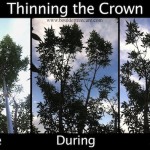 Thinning the Crown is a technique we use to reduce the overall number of branches in trees that have too many. Thinning allows the wind to flow through trees better (helping to reduce the possibilities of damage caused by storms) and sunlight to penetrate the canopy.
Thinning the Crown is a technique we use to reduce the overall number of branches in trees that have too many. Thinning allows the wind to flow through trees better (helping to reduce the possibilities of damage caused by storms) and sunlight to penetrate the canopy.
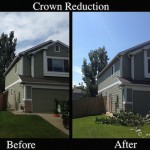 Crown Reduction is a method used when we want to properly reduce the overall size of the tree. This is not the same as topping a tree nor is the same as making a bunch of heading cuts (see: Topping and Heading Cut definitions below).
Crown Reduction is a method used when we want to properly reduce the overall size of the tree. This is not the same as topping a tree nor is the same as making a bunch of heading cuts (see: Topping and Heading Cut definitions below).
 Directional Pruning is a technique we use to help manage which way twigs, branches and trees grow.
Directional Pruning is a technique we use to help manage which way twigs, branches and trees grow.
 Crown Restoration is implemented when a tree has grown structurally unsound, experienced damage caused by storms or previous topping.
Crown Restoration is implemented when a tree has grown structurally unsound, experienced damage caused by storms or previous topping.
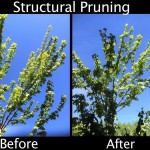 Pruning to Improve Structural Integrity. Structural pruning is used when a tree is young to help create a strong foundation which the tree will grow. It is also used when a tree is older and has developed weakness in it’s form. This may require the implementation of several different pruning techniques to help strengthen the core integrity of a tree.
Pruning to Improve Structural Integrity. Structural pruning is used when a tree is young to help create a strong foundation which the tree will grow. It is also used when a tree is older and has developed weakness in it’s form. This may require the implementation of several different pruning techniques to help strengthen the core integrity of a tree.
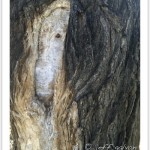 Pruning older trees (see: cleaning of the crown) The removal of dead, damaged, diseased wood. Also, branches that cross, rub one another or otherwise do not seem to be growing in a beneficial direction. Unless it is completely unruly, storm damaged or there is a specific problem, we generally avoid making large cuts into living plant tissue on older trees.
Pruning older trees (see: cleaning of the crown) The removal of dead, damaged, diseased wood. Also, branches that cross, rub one another or otherwise do not seem to be growing in a beneficial direction. Unless it is completely unruly, storm damaged or there is a specific problem, we generally avoid making large cuts into living plant tissue on older trees.
 Pruning Fruit Trees. To help reduce the chances of transmitting diseases, we recommended (unless there is a specific problem to address) pruning fruit trees during in the winter months, when they are dormant.
Pruning Fruit Trees. To help reduce the chances of transmitting diseases, we recommended (unless there is a specific problem to address) pruning fruit trees during in the winter months, when they are dormant.
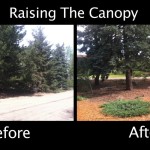 Raising the Canopy on trees to improve visibility, fire mitigation, forestry and landscapes.
Raising the Canopy on trees to improve visibility, fire mitigation, forestry and landscapes.
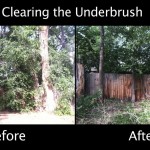 Clearing the Underbrush is useful when the growth at the base of trees is problematic or has an unpleasant appearance.
Clearing the Underbrush is useful when the growth at the base of trees is problematic or has an unpleasant appearance.
Pruning Young Trees establishes a strong foundation and helps minimize the risk of tree failure caused by poor branch locations and weak branch unions.
Vista Pruning – Pruning for a better view, from your house or deck, is best accomplished if done in balance and alignment, keeping the overall health of the tree in mind.
Heading Cut is a cut made mid-branch (sometimes without a small secondary branch nearby) often these cuts are used after severe storm damage. Although, sometimes they are used on shrubs and young trees in nurseries.
Topping is not a recommended pruning technique and should be avoided unless there is no better alternative. We choose to use these cuts only in rare instances (severe storm damage to crown). As a general rule, it will create a weaker tree (often requiring a crown restoration) than using proper pruning techniques such as a crown reduction.
Pollarding and Espalier pruning techniques are used to create very specialized affects such as with fruit trees or to manage the growth of some large trees.
We inspect to ensure our cutting blades are clean and sharp before making cuts and we always use proper pruning (trimming) principles to avoid damaging the cambium. Clean, smooth cuts will help the tree to heal more rapidly, improve appearance, and, can reduce the chances of transmitting diseases.
If a tree is dead, beyond rehabilitation, or is considered no longer safe – Boulder Tree Care also provides complete tree removal and stump grinding services.
Descriptions of tree pruning techniques provided by Boulder Tree Care in Boulder, Colorado USA.